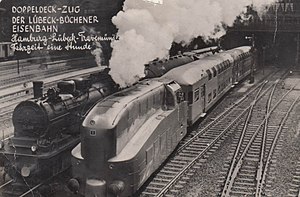LBE No. 1 to 3
| LBE 1–3 DR series 60 |
|
|---|---|
|
LBE
|
|
| Numbering: | DR 60 001-003 |
| Number: | 3 |
| Manufacturer: | Henschel |
| Year of construction (s): | 1936-1937 |
| Retirement: | 1962 |
| Type : | 1'B1 'h2 |
| Gauge : | 1435 mm ( standard gauge ) |
| Length over buffers: | 12,380 mm |
| Service mass: | 69.0 t |
| Friction mass: | 36.5 t |
| Wheel set mass : | 18.3 t |
| Top speed: | 120 km / h |
| Driving wheel diameter: | 1,980 mm |
| Impeller diameter front: | 1,000 mm |
| Rear wheel diameter: | 1,000 mm |
| Cylinder diameter: | 660 mm |
| Piston stroke: | 400 mm |
| Boiler overpressure: | 16 bar |
| Grate area: | 1.40 m² |
| Superheater area : | 26.00 m² |
| Evaporation heating surface: | 75.36 m² |
| Locomotive brake: | single release air brake |
The locomotives with the track numbers 1 to 3 of the Lübeck-Büchener Eisenbahn (LBE) were streamlined tank locomotives . The machines with the 1'B1 ' axle arrangement had a two-cylinder superheated steam engine and were capable of push-pull trains . In order to obtain a symmetrical running gear, both running axles were designed as Bissel axles , which were equipped with reset devices for better guidance.
history
In order to speed up the rapid passenger traffic between Hamburg and Lübeck , the LBE commissioned the Henschel locomotive factory in Kassel to build three of these machines in 1935 . At the same time, the double- deck wagons belonging to the locomotive were manufactured by the wagon building companies WUMAG in Görlitz and Linke-Hofmann in Breslau (see also LBE's double-decker streamlined push-pull train ).
Locomotives LBE 1 and 2 were delivered in 1936, locomotive LBE 3, which was a little heavier with larger water tanks and a larger boiler, followed a year later. The machines had a top speed of 120 km / h and were used in push-pull operation. Due to their appearance and the gray paintwork, they were soon nicknamed "Mickey Mouse".
The locomotives had an electrical remote control device, the controller was operated in pushed mode by means of a servomotor and roller chain from the driver in the control station, the stoker took over the remaining tasks. The communication took place by bell and telephone.
When the LBE was nationalized on January 1, 1938, the locomotives were sorted into the numbering scheme of the Reichsbahn as class 60 with the numbers 60 001 to 60 003 and housed in BW Lübeck, Reichsbahndirektion Schwerin . Until the outbreak of war in 1939, nothing changed in operational use. Then the express service was stopped and the three locomotives were to be retired.
There were efforts to sell the machines to the FKE , but these locomotives were designed for high-speed traffic in the north German lowlands, and not for the Königsteiner Bahn , which also has quite steep sections. During the load test drive, only two of the 14 wagons attached to Frankfurt-Höchst arrived in Königstein, the rest had to be gradually uncoupled on the route.
The 60 001 was used as a heating locomotive and went missing during the war. The other two went to the Deutsche Reichsbahn . 60 002 served in the Berlin area until 1958, was placed on Z at the Wustermark depot from 1960 and scrapped in Leipzig in 1967 . 60 003 was in service at the Stralsund depot until 1954 .
literature
- Rüdiger Otahal: The Lübeck-Büchener Railway. GeraMond Verlag, Munich 2002, ISBN 3-7654-7130-5

